
Once in the new land of opportunity, many ancestral parents could barely afford their family an elementary level education, yet saw a child attain distinction. Greatgrandfather, Ole Hemmingson (1851-1903), headed such a family.1, 2 He produced two such children. Same father, different mothers.
Matt Hemmingsen (1876-1967) was told “your mother has died, so you must tend to the farm”. He had just docked from Norway, an eleven-year-old boy lettered to the fourth-grade, when he heard this directive.1 Matt soon left the farm for logging to become a notable man of the Canadian woods. He was a risk-taker, an entrepreneurial lumberman, a gold-miner and patent holder.2 Matt is celebrated on this blog as Granddad, under this tab, and “Memories”
Clarence Hemmingsen (1895-1987) was eight when he got “your father has died, so we must sell the farm”.1 This is his story.
Clarence added a five-year apprenticeship on top of his eighth-grade lessons to become a steam fitter.1 The Union Man then enrolled in the Proletarian University in Chicago. Once learned in the doctrine, he became a Proletarian Party Official. Click here to view its 1923-25 roster. Throughout his life, Clarence sought personal freedom, where that meant he could freely express and live his radical socialist philosophy.3

Endowed with the art of talk, Clarence became a soap box and convention speaker. A believer in full command of Marxist theory, he delivered it precisely, in a pleasant voice of natural full-chested volume. We know this, because he sat for interviews late in life. In one such interview, the old man of 86, spoke practically uninterrupted for three hours of colorful and fact-filled reminiscence. Audio file and transcript result of those interviews will be woven into his story.
One of his interviewers, Thomas Gerald O’Connell wrote “Farmer-Labor Movement History” as part of his PhD thesis. He ends with an epilogue on Clarence, a portion of which is captured to the right. We greatly appreciate his permission to use it.
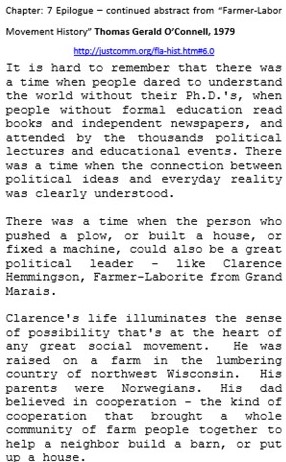
O’Connell’s piece is most interesting. It reveals competing forces of Clarence’s day; the rise of socialism and communism within the US and worldwide, the Farm Labor Movement under the backdrop of the Great Depression. It shows discord within and between rival philosophies, in the FLM, in the paths of the AFL and CIO, then the combined organization. As well, Minnesota gubernatorial races.
Of the farm and as a working man, Clarence understood the impact of stressors that would mark his time. Because of his presence he was called to design models of, and lead resistance to housing evictions.
“Twentieth Century Radicalism in Minnesota Oral History Project: Interview with Clarence Hemmingsen, Minnesota Historical Society” is gratefully permitted by that Society. These later interviewers were William Kosiak and Carl Jarvi.
Click here for an AUDIO TAPE of their interview. It is divided into four Parts and will open in a new window. The time counter for segments relevant to this post will be given throughout the post, so it will be helpful to leave that window up. Transcript is available, but is unedited and annoyingly difficult to follow. The audio, though, is serious fun. In fact, the transcript can be read as angry, whereas the interview was anything but. Clarence delivered with chuckle, and is often downright amusing.
In addition to hearing Clarence in his own voice, the Kosiak/Jarvi audio holds wonderful reminiscences on his brothers Henry and Matt. Both O’Connell and Kosiak/Jarvi provide much more depth including Clarence’s close association with movement notables such as Eugene Debs, Clarence Darrow and Minnesota Governor Elmer Benson.
Talk and his sense of honesty were among Clarence’s assets. They got him into a heap of trouble with power. In Part I from 21:00 to 28:00, he claims to have been confronted by labor leader George Meany. It was autumn, 1930. Their politics were not aligned, to say the least, and the senior offered him a get-rich “shake down” job to get him off the soapbox. Unsuccessful, Mr. Meany then tore his Union Card to shreds, and left him unemployable. Clarence goes on to say how he talked careful, in respect of George’s alleged hired killer. The “powers that be” thought they broke him. Success though, is in the spirit of the beholder, and he was most humble and obstinately self-confident. The unemployable Clarence shook it off and went on to lead a simple, happy constructive life.
It was shortly after that event, when reduced to housekeeping rooms, Clarence was called to remedy growing evictions in Chicago. His response: Part 2 at 1:27 to 9:40. It is great insight into housing conditions of the early 1930s depression. His success became well-known, and was model for other cities. At that time, he was sounding like a single man, although that was not articulated.
CLARENCE: EARLY YEARS
RECAP: The men’s heritage, sketched over the last several posts, tells that Ole Hemmingson and his wife, Berith, brought their family from Norway to a homestead in northwestern Wisconsin, in the 1880s. He was a surveyor, involved in road construction. She died soon after the move, then Ole married Alette. Thus, he had a family of immigrant children and another of first-generation Americans. O’Connell gave Clarence’s tribute to Ole, in his fifth paragraph, boxed right, above.
There were fourteen children in all, with nine surviving to adulthood. Three of them were immigrants; they migrated to the west coast. Six were American-born. They remained close to their origin, always residing in states of the Great Lakes. All led well-directed lives, the finest measure of parental success.
Clarence was the tenth child in the queue of boy-heavy siblingship. He was nineteen years Matt’s junior. Matt was already out of the house living the logger’s life, but remained available in the area for another decade. Born in 1895 of Alette, Clarence soon relinquished “the baby” status.
Clarence was the largest of Alette’s boys with an adult stature of 5’11” and 200 pounds. Here he is at fifteen.5 He was blue eyed, of light complexion, with brown hair. 1 Clarence Hemmingsen was physically fit, assumed, because he trained as a heavy weight fighter.4
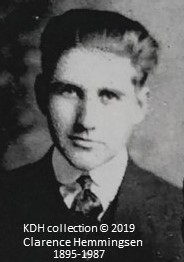
We will come to appreciate his bright mind and realize he kindly took no guff. Oh yes, he probably exerted authority amongst his siblings. Authority of confidence, not malice. That he could persuade was likely evident in 1895.
He was born into a family exhausted from the necessaries of sibling Marie’s TB.1 It is easy to imagine his little self, shushed from noisy toddler activity, in the months of her passing. Mildred appeared about then and the new century brought Earl. At that time, only Alette’s children remained in the home. Two more babes would come: Grace the next year, and Paul on 18 APR 1903. Alette had eight children in all, for she had brought a son with her, from Norway. 1
THE DIE IS CAST
Ole died the year Paul was born, in fact, on 5 MAY. Our heart goes out to Alette. Clarence was eight. He probably could not see his sweet little brother through his torrent of tears. The rest of his life awaited him.
The world crashes down and little ones must grow up. We would be remiss to neglect the part of his back story that was truly wonderful. The run of the homestead with cows, horses, chickens and all. Fishing with Dad and brothers. Pulling Mildred’s hair. Idling away precious free time. That is, whittling for hours, looking nothing but peaceful, while totally immersed in thought. Bird songs actually registering. Not to forget, telling teacher he had to milk the cow, rather than sit at the desk in the one-room schoolhouse we showed last time. The kind of stuff that makes the adult pine for home.
MORTGAGING, CONFIRMING AND SELLING
By 1905, Alette had mortgaged the homestead. Only that year’s census disclosed her eight children at once, for Grace was lost shortly thereafter.
Clarence was confirmed in the Lutheran Church in 1909.1 We can imagine that Sunday best was donned with resistance, followed by some spit-ball activity at the event, for the adult staunchly declared no belief in supernaturalism. That was his own euphemism, to avoid offending anyone religious.
The homestead stopped making sense for the widowed aging Alette and/or the belt had to tightened, so they moved to a rented home by 1910. Her Norwegian-born son died in 1911, leaving Alette with the six American-born children who would become adults: Henry, Arthur, Clarence, Mildred, Earl and Paul. At this point, they were together, still in Bayfield County, Wisconsin. Only Mildred married and raised a family there. That everyone kept close, though, is evident from their documents.
CLARENCE OUT IN THE WORLD, AND INTO JAIL
Clarence said he left home at fourteen.4 He must have been packed and ready as the 1910 Census was being taken. He was already no stranger to hard work for he was listed as a laborer in a sawmill, a man-boy, fully done with school at the eighth grade.1 He spent the next several years, in the Bayfield area, learning the steam fitting trade.
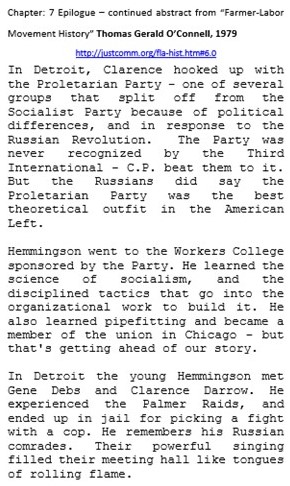
His Draft Card shows he was in Detroit MI by June 1917, working as a Marine steamfitter for the Detroit Shipbuilding Company. Perhaps it was a war readying program.
Clarence married Nettie Jackson, born David in Macomb MI in 1919, at the Justice of the Peace.1 She was older and previously married; the next year’s census in Detroit supported a step-daughter for Clarence. The disposition of this marriage and the step-daughter is unknown, but the marriage lasted at least until 1930.
Nettie is not mentioned in the interviews, such that we do not know her response to Clarence’s activities. The Palmer “Red’ Raids, that O’Connell referenced in paragraph eight (column to the right), resulting in a jail visit, were conducted around 1920.

By 1924-25, Clarence was speaking statewide in Illinois, centered in Chicago. Nettie moved there with him, as evidenced by Census 1930. It was taken around the time George Meany scuttled him from the United Association of Plumbers and Steam Fitters, and he was listed unemployed at that census. Clarence tells us that he had to fund his speaking tour transport. He did so in an 1928 Dodge that he conformed to a one man sleeping accommodation. It sounded quite the rugged go.
Clarence married Edna Hennigan. Interviews suggest this couple was together by 1932. He talks about meeting her in Part 2 at 9:44 to 10:42, pondering how to be a good sweetheart and provider with his unemployed status. It is precious.
By 1935 the couple had moved to an abandoned cabin by Lake Superior in sparsely populated, rural Cook County. Note: Chicago is in Cook County, IL. Interview references to Cook County, however, are to Cook County, MN
Clarence mentioned an adopted son but neglected to tell of his mother.4 Otherwise, this couple also seemed to be childless.
UNEMPLOYED
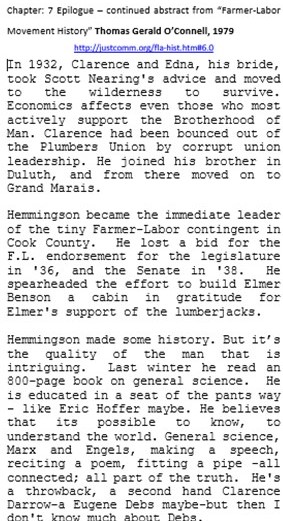
A decade of chronic unemployment was evident on the 1940 Census, with Clarence stating he was seeking work as a Plumbing and Heating Contractor.1 One might conclude he had fallen victim to the Great Depression, but the circumstance was just a clue to this broader narrative. Such the treat for our genealogy to have the truth of one of ours, born in the 1890s, be revealed in transcript and voice.
Their rural habitat was be an excellent choice for an unemployable person who was skilled in the art of homestead. In fact, while they began their experience in abandoned cabin, they ultimately built a small resort. Clarence credited Edna with bringing some much-needed bacon home through her painting artistry.
CLARENCE AND MATT: EARLY 1930s
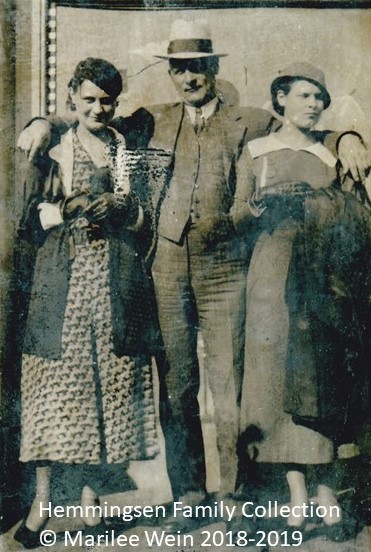
This is a family history. Sometimes things are just too delicious, not to include. Perhaps the reader wonders why the snippet on Matt was included in the discussion of Clarence. Especially since Matt, in British Columbia, was long out of the picture. Yet, a picture is the reason for his inclusion.
This snap is deteriorated to toss-out status, except that … drumroll … it was taken in Chicago, about 1933. It is Granddad with his daughters, Margaret and Marie at the Chicago’s “Century of Progress”. It ran from May 1933 to October 1934.
Audio shows that Clarence was with Edna during the visit, although his recollection puts it at 1934-35. We bet they made it to the supposed reunion party coming up, but not to the Chicago event.
Audio Part 4 from 12:17 to 18:40 starts with Clarence declaring that “I never took nothing and so I didn’t degenerate depending on somebody else”. That is a great preface to what comes next: discussion of a small loan on which Granddad did not want to receive payment. Granddad suggested he should have requested much more. It is followed by Clarence’s old age reflection of Granddad’s life journey and of Clarence’s contentment with his own self-made success.
The old man, obviously still brilliantly acute, then reflects on his life in a nursing home, with no one up to the game of talk.
PAUL’S PLACE OR MILDRED’S?
Youngest brother, Paul, left the homestead for Chicago IL where he settled as a street car conductor for Chicago Surface Lines. He was there, with his wife and son, so said Census 1930. Earl was boarding in their home. Clarence and Nettie were in the Windy City too. Within a year or two, though, Clarence would be with Edna.
Paul would have been a great help in 1933, helping Matt navigate the big event. It seems from the interviews that Clarence had already shoved off to Minnesota, with Edna – and Earl was likely plying the Great Lakes.
Yes! The big homecoming party would have been at Mildred Dybedal (Hemmingson)’s. After all, only she had a homestead and it was actually at home. We just know it was in Wisconsin. More so, because brothers Arthur and Henry, along with Henry’s wife Mary, were in Duluth MN, the big city closest to Bayfield. So was Matt’s step-mom Alette.
Margaret and Marie were pictured with Granddad. We can wonder if Granny came along with John, Bill and Bob.
HENRY “HANK” HEMMINGSON AND GEORGE MEANY
With unemployment caused by the depression, plus that imposed by Meany, staying in Chicago was impossible. Clarence and Edna went to Duluth MN, where brother Henry lived, with wife Mary. Mary’s parents were French Canadian, but she was born and raised in the Washburn-Bayfield area. Hank’s trade was electrical welding. In Part 2, at 10:58 to 16:20, Clarence tells us of Hank’s success with Hemmingsen Inc., which was respected far and wide. It ends with Clarence clearing out for more northern and secluded Minnesota, worried that George Meany would close down Hank’s business out of revenge. Between the beginning and end of the passage, Clarence goes into a hilarious account of his atheist self, working for Catholic Priests: “I enjoyed having a discussion, them people are goddamn well educated”.
CLARENCE: EARLY 1940s
As said, the 1940 Census painted a dour picture of Clarence’s life. The audio tapes reveal something quite different. He and Edna lived an enviable splendid life together. He said she was beautiful and smart; very popular. The jovial nature of this “uneducated well-read man” must have been a perfect match.
His prospects improved by 1942. His Draft Card reported him under employ of Leatham D Smith Shipbuilding Company in Sturgeon Bay, Wisconsin. This outfit was part of WW II Emergency Shipbuilding Program. The telephone number for family was left blank. Thrifty.
The program ended in 1945. That was the last official document we found.
CLARENCE: LATER YEARS
The interviews must bridge the gap from 1945 until he died in 1987. O’Connell’s is dated 1979; Kosiak/Jarvi’s, sometime between 1980 and 1989. Clarence, who died in 1987, was upset with the Reagan presidency. It seems, then, that the Kosiak/Jarvi interview was sometime between 1981 and 1987. In the audio, Clarence said his doctor had visited the week prior, at which time he was 86 – an anecdote that could be off. It would, however, put the interview in 1981. Further, despite his antagonism toward Reagan, Clarence did not mention the assassination attempt, which may indicate an early 1981 sit-down.
If early 1981 is correct, then the interview would have been taken as the “Misery Index” that sank the Carter Administration, slipped into the recession of the early Reagan era. It would have preceded the rise of Gorbachev and our realization that the USSR was under adverse economic outlook, and would ultimately dissolve.
With the above in mind, between Part 3 at 5:15 to 10:00 and Part 4 at 11:40 to 12:20 Clarence opined that the rich were in control of the country and that unemployment was a permanent institution. He thought Lenin was a genius and “the best Marxist”. Clarence saw that the Soviet Union had vast resources and felt they would become dominant in five years. He thought they would develop a “super race”, where that meant children were removed from parental advice on education, especially of religion. Thus, over some generations, they would be uncorrupted of the notion that reward would be found in the thereafter. They would listen to the sensible state. He saw great gas reserves, and thought the “collective will of the first working class” of socialists would get the pipeline done for the benefit of all.
LAST ACTIVIST ACTIVITY
Those last passages also reveal that Clarence attended a Democrat Caucus with intent to have Congress remove Ronald Reagan from office. He said his Doctor advised him against travel, as he was, by then, unwell.
AND THEN
The interviews show may other interests for Clarence. He was a heavy-weight reader, adept with poetry, and lover of art and science. He organized Senior Citizens, and where ever possible, did his own brand of anti-smoking campaigns. A win for him, was in defeating corruption in Washington, to have Highway 61 in Minnesota placed to the better benefit of local citizens. As well, he was highly involved in State politics. He made a mark.
Whatever one may think of his politics, he was one of immense integrity. His intent was to help others build a better society. He lost his father at eight, was on his own at fourteen, and robbed of his hard-won steam-fitter trade. If one listened to the audio, one heard that the “once-in-a-lifetime” offer he declined, was to be set up to negotiate for himself first. Only after securing payoff for self, should he worry to negotiate for workers. He could not. For that, he incurred revenge. His response was selfless, not bitter. Thank-you dear great half-uncle, Clarence Marion Hemmingson (1895-1987).
Author: Doublegenealogytheadoptionwitness copyright © Marilee Wein 2018-2019. All rights reserved.
Notes and Sources:
1 Norway Census, BMD and Emigration data, plus US Immigration, Census, BMD, Lutheran Church and Draft Data, plus State Census and BMD on Hemmingsen Family members have been detailed in three previous posts on marileewein.com (1. Dear Granddad: If Only November Had Been August, 2. If Only November Had Been August: What Came Next, and 3. TB Was Not On The Draft Card: Was Disaster?”)
2 The Hemmingsen Family Collection including “John O Hemmingsen / Mary Margaret Hemmingsen (Dickson)” authored 1999 by John Oliver Hemmingsen. All materials posthumously published here are copyright © Marilee Wein 2018-2019. All rights reserved.
3 Thomas Gerald O’Connell, “Farmer-Labor Movement History” 1979 found at http://justcomm.org/fla-hist.htm#6.0
4 “Twentieth Century Radicalism in Minnesota Oral History Project: Interview with Clarence Hemmingsen, Minnesota Historical Society” Interviewers: William Kosiak and Carl Jarvi. conducted at Grand Marais, MN ca 1981. https://www.mnhs.org/
5. Gratefully allowed by the Kofal-Dybedal-Hemmingson Family Collection
Wow! I love that Clarence took life’s troubles and pitfalls with integrity and a sense of humor. Not allowing anger to rule his nature. Today’s society could learn a lot from Clarence even if they don’t abide in his politics.
PS Love the picture of Grandad.
LikeLiked by 2 people
Agree! I respected and liked him more and more, as I continued to listen. Quite the man. I wanted to borrow your Mom’s iron to press Granddad’s suit which looks all rumpled in the pix. Aunt Marie would be aghast at the condition of her dress! Aunt Margaret would simply shrug her shoulders and laff.
LikeLiked by 2 people
So well written and very interesting. I would have loved to have talked with
Clarence! Thanks for the great blog!
LikeLiked by 3 people
Karlyn, thanks so much for commenting! Agree on the chat, but what a treat to hear him. My brother guffaws much the same. Eerie.
LikeLike
Wow! This is fascinating! Thanx for all the research!
LikeLiked by 3 people
Very happy that you found it interesting!
LikeLike
Those poor boys to grow up so fast!
LikeLiked by 3 people
They did for sure, and were credit to their parents.
LikeLiked by 1 person
Wonderful biography. Integrity is much admired but seldom practiced and never in Labor or Politics.
LikeLiked by 4 people
Thanks for your thoughtful comment and I agree wholeheartedly
LikeLike
Wow, it’s awesome that the Minnesota Historical Society has audios of Clarence telling his story.
LikeLike
It is, for sure. Sometimes his voice modulation and chuckle sounds like my older brother. However, Clarence was half-great uncle, and I’m not sure if voice is an inherited characteristic in the first place.
LikeLiked by 1 person